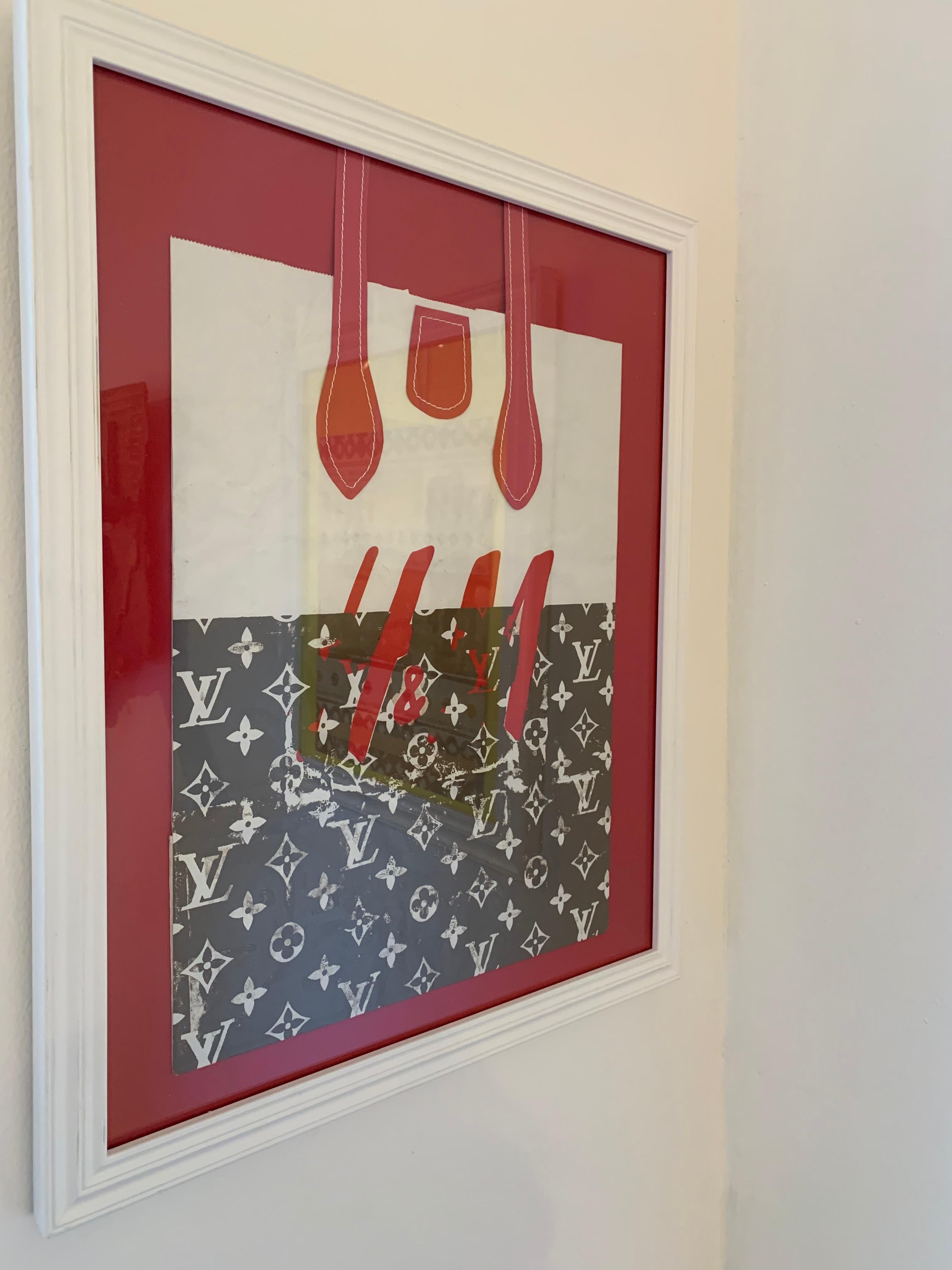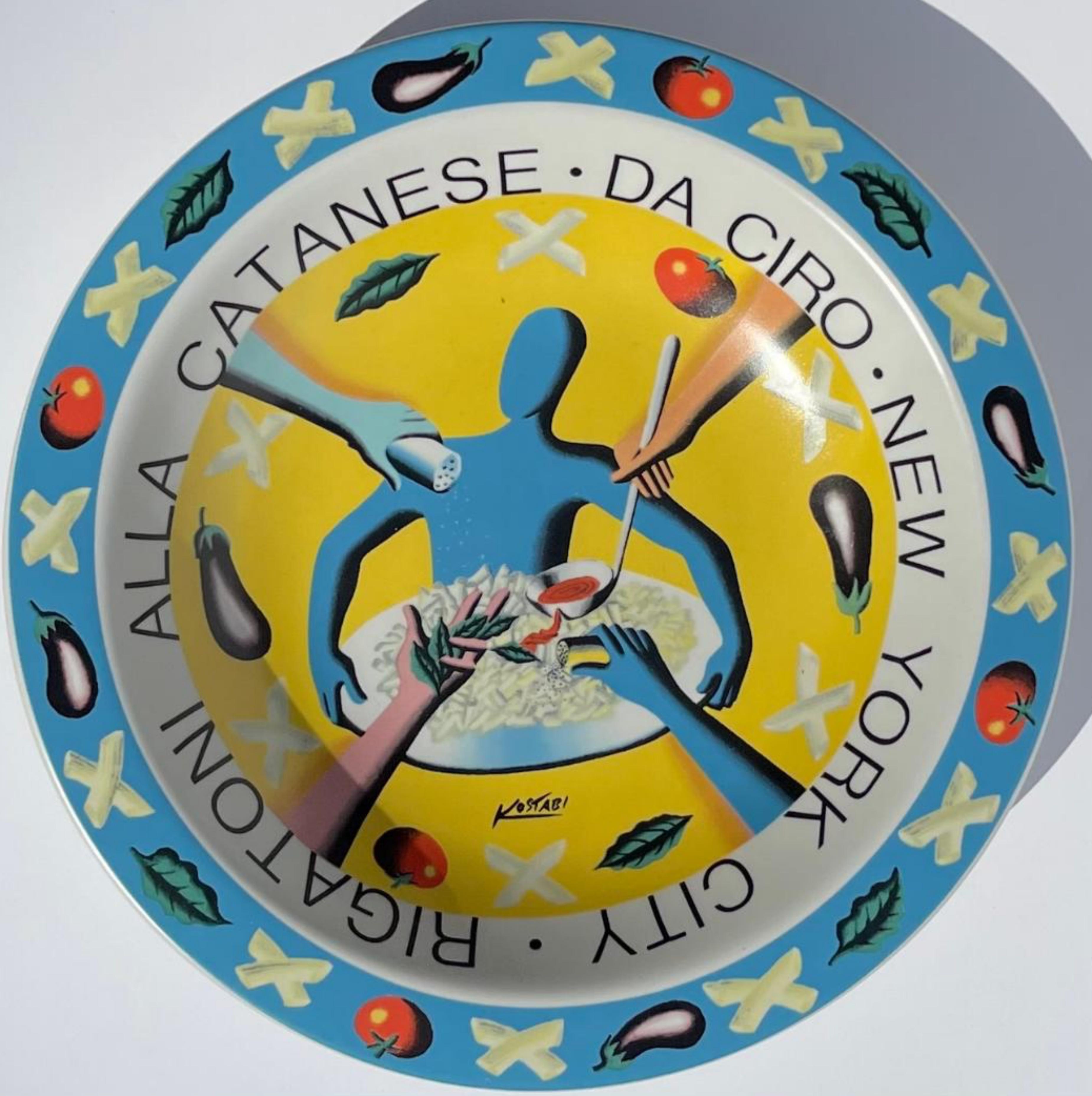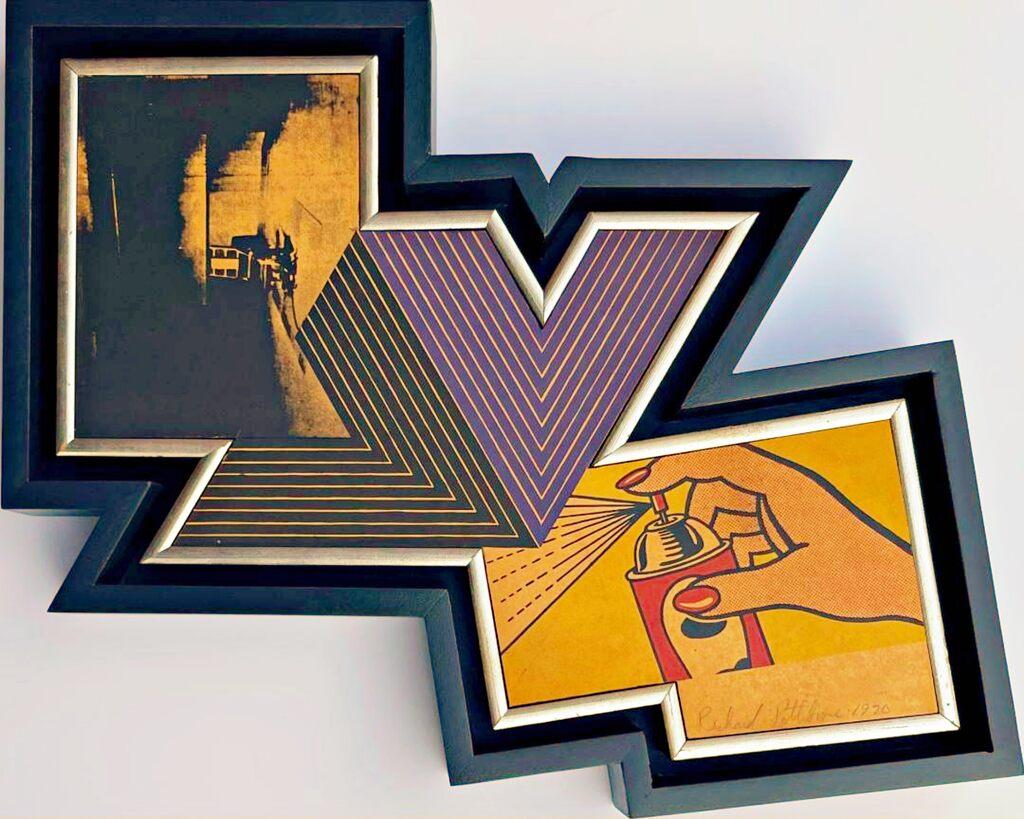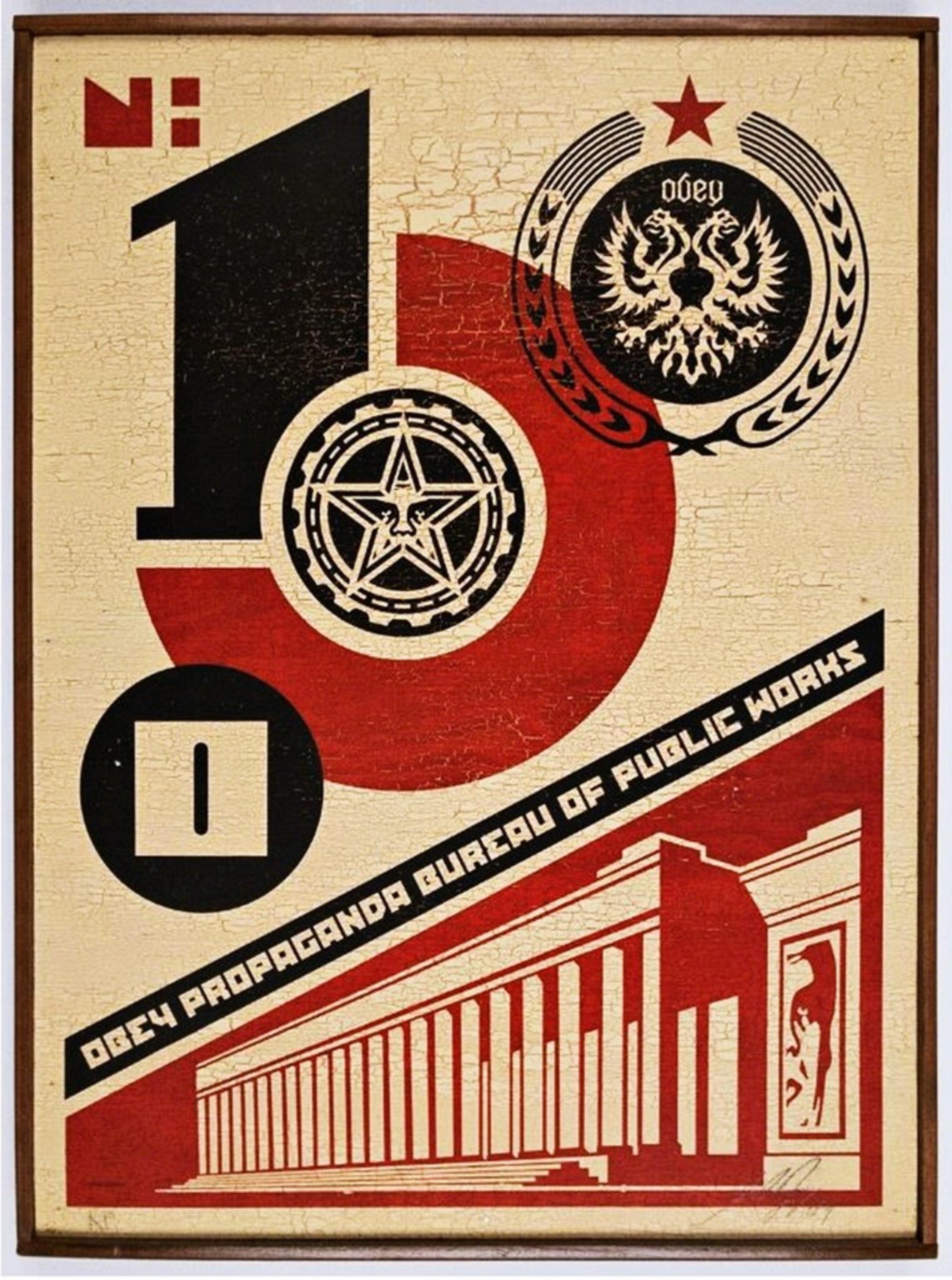Items Similar to The Daily Arf (Silkscreen and intaglio of man reading a newspaper with his dog)
Want more images or videos?
Request additional images or videos from the seller
1 of 8
Red GroomsThe Daily Arf (Silkscreen and intaglio of man reading a newspaper with his dog) 1974
1974
About the Item
Red Grooms
The Daily Arf, 1974
Embossed Silkscreen and Blind Intaglio
Hand signed and numbered: Pencil signed and dated 1974 lower right; pencil numbered from the edition of only 12 Artist's Proofs.
Frame included: held in original vintage frame
Embossed Silkscreen and Blind Intaglio. Pencil signed and dated 1974 lower right; pencil numbered from the edition of only 12 Artist's Proofs.
This work is one of only 12 rare Artist proofs. In this playful piece, an eager dog greets a bespectacled man who reads a newspaper titled 'DAILY ARF' Blunt, geometric forms intermingle to illustrate the scene, capturing the energy and comedy for which Red Grooms is known. This work is Plate #43 in the Red Grooms catalogue raisonne, "Red Grooms: The Graphic Work". Here, the artist shares more insights:
"The embossing was done by a lovely middle-aged couple. I wish I could remember their names. They seemed to work out of their own living room doing this unusual art form, embossing..."
This work is matted and framed with plexiglass. The work itself appears to be in excellent condition; there are areas of scattered stains to mat along bottom and left side - easily replaceable.
Measurements:
Framed: 22.5 inches by 16.5 inches
Full Sheet: 20.75 x 15.5 inches (matted)
Catalogue Raisonne Reference: Knestrick, 43 (page 80)
- Creator:Red Grooms (1937, American)
- Creation Year:1974
- Dimensions:Height: 22.5 in (57.15 cm)Width: 16.5 in (41.91 cm)Depth: 0.5 in (1.27 cm)
- Medium:
- Movement & Style:
- Period:
- Condition:Fine condition; not examined outside of original vintage frame. Frames are not guaranteed.
- Gallery Location:New York, NY
- Reference Number:1stDibs: LU1745213169372
Red Grooms
Charles Roger Grooms was born in 1937 in Nashville, Tennessee, a city that, with its lively honky-tonk scene and the theatricality of the historic Grand Ole Opry, would later influence much of his work. Nicknamed for his ginger hair, Red enrolled at the Art Institute of Chicago in 1955. A self-proclaimed “restless and undisciplined student,” Grooms spent the next few years moving between schools and cities, including the New School in New York, Peabody College (now part of Vanderbilt University) in Nashville, and Hans Hofmann’s summer school in Provincetown, Massachusetts. Frustrated with the academic track and anxious to enter the New York art scene, Grooms abandoned formal education to focus exclusively on creating art and securing exhibition opportunities in his Chelsea neighborhood. There, he found quick success and a supportive circle of artists that became close friends and collaborators. From the start of his career, Grooms has worked in multiple media, from painting, printmaking, and sculpture, to installation art, filmmaking, and theatrical experiences known as “Happenings.” Much of his art blurs the boundaries between these different forms, such as his large-scale, carefully-crafted environments he calls “sculpto-pictoramas,” and smaller objects like Dalí Salad. In this example, Grooms combines silkscreened and lithographic elements with a wooden base and acrylic dome to create a three-dimensional portrait of the famous Surrealist artist. Grooms is perhaps best known for his colorful and comedic commentary on the culture, politics, and figures associated with the American urban environment and art historical traditions. Relying on satire and caricature, Grooms’ art has paid homage to a wide range of artists including Rembrandt, Auguste Rodin, Thomas Eakins, and Benjamin West, as well as national icons like Thomas Jefferson and Chuck Berry. Grooms’ disparate output is so difficult to classify that he has been compared to the influential Dada artist, Marcel Duchamp. Like Duchamp, Grooms often deliberately confronts the art world establishment, noting in 1974 that “it’s good to have . . . something to go against.” Despite his affinity for defying the mainstream, Grooms is routinely cited by scholars as one of the leading American artists of his generation and was honored with the National Academy of Design’s Lifetime Achievement Award in 2003. The subject of a 1984 mid-career retrospective exhibition held at the Pennsylvania Academy of the Fine Arts, the artist’s work can be found in public collections across the United States, including the Metropolitan Museum of Art, the Whitney Museum of American Art, and the Hirshhorn Museum and Sculpture Garden, as well as in many international museums. - The Johnson Collection, Spartanburg, South Carolina
About the Seller
5.0
Platinum Seller
These expertly vetted sellers are 1stDibs' most experienced sellers and are rated highest by our customers.
Established in 2007
1stDibs seller since 2022
294 sales on 1stDibs
Typical response time: 1 hour
- ShippingRetrieving quote...Ships From: New York, NY
- Return PolicyA return for this item may be initiated within 1 day of delivery.
More From This SellerView All
- Recent Still Life (1966 limited edition, Hand signed and dated by Jasper Johns)By Jasper JohnsLocated in New York, NYJasper Johns Recent Still Life (Hand signed and dated by Jasper Johns), 1966 Collotype. Hand signed and dated by Jasper Johns Edition of 2100 (this work is, exceptionally, hand signed & dated by Johns; the regular edition is not) Signed and dated lower right front by Jasper Johns in graphite pencil August, 27, 2008 Provenance: Estate of artist and noted collector Rick Collar Framed This scarce early (1966) limited edition collotype was published on the occasion of the exhibition "Recent Still Life" at the Museum of Art, Rhode Island School of Design. The regular unsigned edition was 2100, and the official signed edition was 100; however, exceptionally, Jasper Johns signed...Category
1960s Pop Art Abstract Prints
MaterialsPhotogravure
- Saying GoodbyeBy Tracey EminLocated in New York, NYTracey Emin Saying Goodbye, 2018 Polymer gravure on Somerset 300gsm Pencil signed, titled, dated, and numbered 71/100 by Tracey Emin on the front Frame Included: Elegantly floated an...Category
2010s Pop Art Portrait Prints
MaterialsEngraving, Photogravure
- Plate for Rigatoni Alla Catanese - Da Ciro - New York, NY,By Mark KostabiLocated in New York, NYMark Kostabi Plate for Rigatoni Alla Catanese - Da Ciro - New York, NY, 2001 Silkscreen on ceramic plate; Microwave and Dishwasher Safe 10 1/5 in diameter Artist signature fired into the plate on the underside and numbered from an edition of 510. Edition 36/510 Makes a wonderful gift! This beautiful, whimsical limited edition, signed and numbered bowl/plate was handmade in southern Italy by master artisans near Vietri sul Mare, was designed by American artist Mark Kostabi. In 2000, Buon Ricordo America, Inc. commissioned famous American artists to design plates for their flagship US restaurants. In 2000-1, Kostabi designed the present work for the NY Italian restaurant...Category
Early 2000s Pop Art Mixed Media
MaterialsCeramic, Screen
- The Appropriation piece: Andy Warhol, Frank Stella, Roy Lichtenstein Unique var.By Richard PettiboneLocated in New York, NYRichard Pettibone The Appropriation Print Andy Warhol, Frank Stella, Roy Lichtenstein, 1970 Silkscreen in colors on masonite board (unique variant on sculpted board) Hand-signed by artist, Signed and dated on the front (see close up image) Bespoke frame Included This is a rare example of Pettibone's iconic Appropriation Print, as it's silkscreened and sculpted on masonite board rather than paper, giving it a different background hue, and enabling it work to be framed so uniquely. The Appropriation print is one of the most coveted prints Pettibone ever created ; the regular edition is on a full sheet with white background; the present example was silkscreened on board, allowing it to be framed in 3-D. While we do not know how many examples of this graphic work Pettibone created, so far the present work is the only one example we have ever seen on the public market since 1970. (Other editions of The Appropriation Print have been printed on vellum, wove paper and pink and yellow paper.) This 1970 homage to Andy Warhol, Frank Stella and Roy Lichtenstein exemplifies the type of artistic appropriation he was engaging in early on during the height of the Pop Art movement - long before more contemporary artists like Deborah Kass, Louise Lawler, etc. followed suit. This silkscreen was in its original 1970 vintage period frame; a bespoke custom hand cut black wood outer frame was subsequently created especially to house the work, giving it a distinctive sculptural aesthetic. Measurements: Framed 14.5 inches vertical by 18 inches horizontal by 2 inches Work 13 inches vertical by 16.5 inches horizontal Richard Pettibone biography: Richard Pettibone (American, b.1938) is one of the pioneering artists to use appropriation techniques. Pettibone was born in Los Angeles, and first worked with shadow boxes and assemblages, illustrating his interest in craft, construction, and working in miniature scales. In 1964, he created the first of his appropriated pieces, two tiny painted “replicas” of the iconic Campbell’s soup cans by Andy Warhol (American, 1928–1987). By 1965, he had created several “replicas” of paintings by American artists, such as Warhol, Roy Lichtenstein (1923–1997), Ed Ruscha (b.1937), and others, among them some of the biggest names in Pop Art. Pettibone chose to recreate the work of leading avant-garde artists whose careers were often centered on themes of replication themselves, further lending irony to his work. Pettibone also created both miniature and life-sized sculptural works, including an exact copy of Bicycle Wheel by Marcel Duchamp (French, 1887–1968), and in the 1980s, an entire series of sculptures of varying sizes replicating the most famous works of Constantin Brancusi (Romanian, 1876–1957). In more recent years, Pettibone has created paintings based on the covers of poetry books by Ezra Pound, as well as sculptures drawn from the grid compositions of Piet Mondrian (Dutch, 1872–1944). Pettibone straddles the lines of appropriation, Pop, and Conceptual Art, and has received critical attention for decades for the important questions his work raises about authorship, craftsmanship, and the original in art. His work has been exhibited at the Institute for Contemporary Art in Philadelphia, the Museum of Modern Art in New York, the Museum of Contemporary Art in Miami, and the Laguna Art Museum in Laguna Beach, CA. Pettibone is currently based in New York. "I wished I had stuck with the idea of just painting the same painting like the soup can and never painting another painting. When someone wanted one, you would just do another one. Does anybody do that now?" Andy Warhol, 1981 Since the mid-1960s, Richard Pettibone has been making hand-painted, small-scale copies of works by other artists — a practice due to which he is best known as a precursor of appropriation art — and for a decade now, he has been revisiting subjects from across his career. In his latest exhibitions at Castelli Gallery, Pettibone has been showing more of the “same” paintings that had already been part of his 2005–6 museum retrospective,1 and also including “new” subject matter drawn from his usual roster of European modernists and American postwar artists. Art critic Kim Levin laid out some phases of the intricate spectrum from copies to repetitions in her review of the Warhol-de Chirico showdown, a joint exhibition at the heyday of appropriation art in the mid-1980s when Warhol’s appropriations of de Chirico’s work effectively revaluated “the grand old auto-appropriator”. Upon having counted well over a dozen Disquieting Muses by de Chirico, Levin speculated: “Maybe he kept doing them because no one got the point. Maybe he needed the money. Maybe he meant it when he said his technique had improved, and traditional skills were what mattered.” On the other side, Warhol, in her eyes, was the “latter-day exemplar of museless creativity”. To Pettibone, traditional skills certainly still matter, as he practices his contemporary version of museless creativity. He paints the same painting again and again, no matter whether anybody shows an interest in it or not. His work, of course, takes place well outside the historical framework of what Levin aptly referred to as the “modern/postmodern wrestling match”, but neither was this exactly his match to begin with. Pettibone is one of appropriation art’s trailblazers, but his diverse selection of sources removes from his work the critique of the modernist myth of originality most commonly associated with appropriation art in a narrow sense, as we see, for example, in Sherrie Levine’s practice of re-photographing the work of Walker Evans and Edward Weston. In particular, during his photorealist phase of the 1970s, Pettibone’s sources ranged widely across several art-historical periods. His appropriations of the 1980s and 1990s spanned from Picasso etchings and Brancusi sculptures to Shaker furniture and even included Ezra Pound’s poetry. Pettibone has professed outright admiration for his source artists, whose work he shrinks and tweaks to comic effect but, nevertheless, always treats with reverence and care. His response to these artists is primarily on an aesthetic level, owing much to the fact that his process relies on photographs. By the same token, the aesthetic that attracts him is a graphic one that lends itself to reproduction. Painstakingly copying other artists’ work by hand has been a way of making it his own, yet each source is acknowledged in his titles and, occasionally, in captions on white margins that he leaves around the image as an indication that the actual source is a photographic image. The enjoyment he receives in copying is part of the motivation behind doing it, as is the pleasure he receives from actually being with the finished painting — a considerable private dimension of his work. His copies are “handmade readymades” that he meticulously paints in great quantities in his studio upstate in New York; the commitment to manual labor and the time spent at material production has become an increasingly important dimension of his recent work. Pettibone operates at some remove from the contemporary art scene, not only by staying put geographically, but also by refusing to recoup the simulated lack of originality through the creation of a public persona. In so doing, Pettibone takes a real risk. He places himself in opposition to conceptualism, and he is apprehensive of an understanding of art as the mere illustration of an idea. His reading of Marcel Duchamp’s works as beautiful is revealing about Pettibone’s priorities in this respect. When Pettibone, for aesthetic pleasure, paints Duchamp’s Poster...Category
1970s Pop Art Mixed Media
MaterialsMasonite, Pencil, Screen, Mixed Media
- City Center Light OperaBy Gerald LaingLocated in New York, NYGerald Laing City Center Light Opera, 1968 Lime colored Screenprint on die-cut Mylar Hand signed, numbered 6/144 and dated in pencil on the front 25 × 35 inches Unframed Gerald Laing Biography Born in 1936, Gerald Laing attended the Royal Military Academy, Sandhurst 1953-1955 and after a short army career attended St Martin’s School of Art between 1960-1964. After art school, Laing lived in New York for five years and then became artist in residence at Aspen Institute...Category
1960s Pop Art Abstract Prints
MaterialsScreen, Mylar
- Bureau of Public Works (Mixed Media on Wood) Twice Signed Artists Proof Ed of 2By Shepard FaireyLocated in New York, NYSHEPARD FAIREY Bureau of Public Works (on Wood), 2004 Mixed media silkscreen on wood panel. Hand signed and annotated on both the recto and verso. In original handmade artist's frame...Category
Early 2000s Pop Art Mixed Media
MaterialsWood, Mixed Media, Screen, Pencil
You May Also Like
- BagsLocated in Santa Monica, CASilkscreen/Collage on Retail BagsCategory
21st Century and Contemporary Pop Art Mixed Media
MaterialsScreen
- 1963 Pop Art Mixed Media Silkscreen on Pillowcase Neon Colors Stephen AntonakosBy Stephen AntonakosLocated in Surfside, FLDREAM New York City, USA Provenance: Charles Byron Gallery, [1965] Silkscreen on linen pillowcase Hand signed. this is not numbered. (it says on gallery label verso edition of 100, I do not know how many were actually made) This is from an early-1960s series of pillows that married cloth, text, metal (including plumbing pipes and nails) and other found objects. The last pillow in the series incorporated the word “DREAM” in neon letters. Stephen Antonakos (Greek: Στυλιανός Αντωνάκος) born in 1926 in Agios Nikolaos, Laconia, Greece – died in 2013 in New York City. Antonakos moved with his family from Greece to the United States at the age of 4 and was raised in the Brooklyn, New York neighborhood of Bay Ridge. Antonakos' work has been included in several important international exhibitions including Documenta 6 in 1977 in Kassel, Germany and he represented Greece at the Venice Biennale in 1997. Anatonakos’s long career, characterized by his creation of brightly colored light installations. Works like Arrival (2008) and Neon Table #1 (1986) have a kinship with the works of Dan Flavin, and the 1960s Light and Space movement of Southern California that included Larry Bell, Bruce Nauman, and Doug Wheeler...Category
1960s Pop Art Mixed Media
MaterialsFabric, Acrylic
- ST18c-Contemporary , Abstract, Gestual, Street art, Pop art, Modern, GeometricBy Francisco NicolásLocated in London, LondonFlowers VIII, 2019 Edition of 25 Digital pigment print Ultrachrome ink on Fabriano Rosaspina paper. Hand signed by the artist, and certificate of authenticity, (Unframed) His work...Category
2010s Pop Art Abstract Prints
MaterialsArchival Pigment
- ST1C11-Contemporary , Abstract, Gestual, Street art, Pop art, Modern, GeometricBy Francisco NicolásLocated in London, LondonEdition of 25 Digital pigment print Ultrachrome ink on Fabriano Rosaspina paper. Hand signed by the artist, and certificate of authenticity, (Unframed) His work has been shown in...Category
2010s Pop Art Abstract Prints
MaterialsArchival Pigment
- ST18e-Contemporary , Abstract, Gestual, Street art, Pop art, Modern, GeometricBy Francisco NicolásLocated in London, LondonFlowers VIII, 2019 Edition of 25 Digital pigment print Ultrachrome ink on Fabriano Rosaspina paper. Hand signed by the artist, and certificate of authenticity, (Unframed) His work...Category
2010s Pop Art Abstract Prints
MaterialsArchival Pigment
- ST1C16-Contemporary , Abstract, Gestual, Street art, Pop art, Modern, GeometricBy Francisco NicolásLocated in London, LondonEdition of 25 Digital pigment print Ultrachrome ink on Fabriano Rosaspina paper. Hand signed by the artist, and certificate of authenticity, (Unframed) His work has been shown in...Category
2010s Pop Art Abstract Prints
MaterialsArchival Pigment
Recently Viewed
View AllRead More
Red Grooms Salutes the ‘Ninth Street Women’ Who Revolutionized Modern Art
In a new show of peppy portraits, the 85-year-old artist looks back at 1950s New York, when the Abstract Expressionists ruled the scene. Only now, the women Ab-Ex artists get more of the spotlight than the men.
Welcome (Back) to the Wild, Wonderful World of Walasse Ting
Americans are rediscovering the globe-trotting painter and poet, who was connected to all sorts of art movements across a long and varied career.






